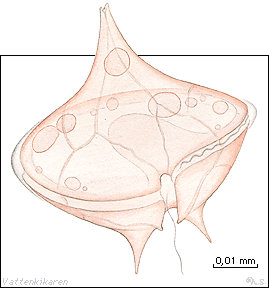 |
 |

 Distribution in scandinavian waters |
Maximum length: 0,30 mm. Compare
with the size of a hair. Appearance: Protoperidinium-dinoflagellates are colourless or yellow to brown in colour with occasional pink or red patches within the somewhat round or diamond formed cells. The cells quite often have thorns or spines. The surface of the cell is broken by grooves that contain two mobile outgrowths (flagellae). The cross-wise groove along the middle of the cell clearly cuts the cell into an upper and lower half. In those cases where the groove goes up towards the upper cell half, it does so only a little bit. The outer casing around the cell is composed of plates that give rise to a rugged and strong armour. Environment: Pelagic. Misc: Protoperidinium-dinoflagellates are found in all Marine areas. With the help of its flagellae these organisms can swim. Protoperidinium-dinoflagellates cannot produce their own nutrition by photosynthesis, they are predators that "eat" other small organisms. They themselves fall prey to different animal plankton, e.g. copepods, and bottom-living suspension feeders. Some specie emit light that is seen in the dark and sometimes resembles seasparkle. In fresh and brackish water, the similar species Peridinium is found, which nearly always contain small green "grains". With the help of these chloroplasts they are able to produce their own nutrients with photosynthesis. Classification: Protoperidinium-dinoflagellates are members of the dinoflagellate group under the "protists". The protists is not a well defined group, as it is often used for organisms that are not bacterias, fungi, plants or animals. |